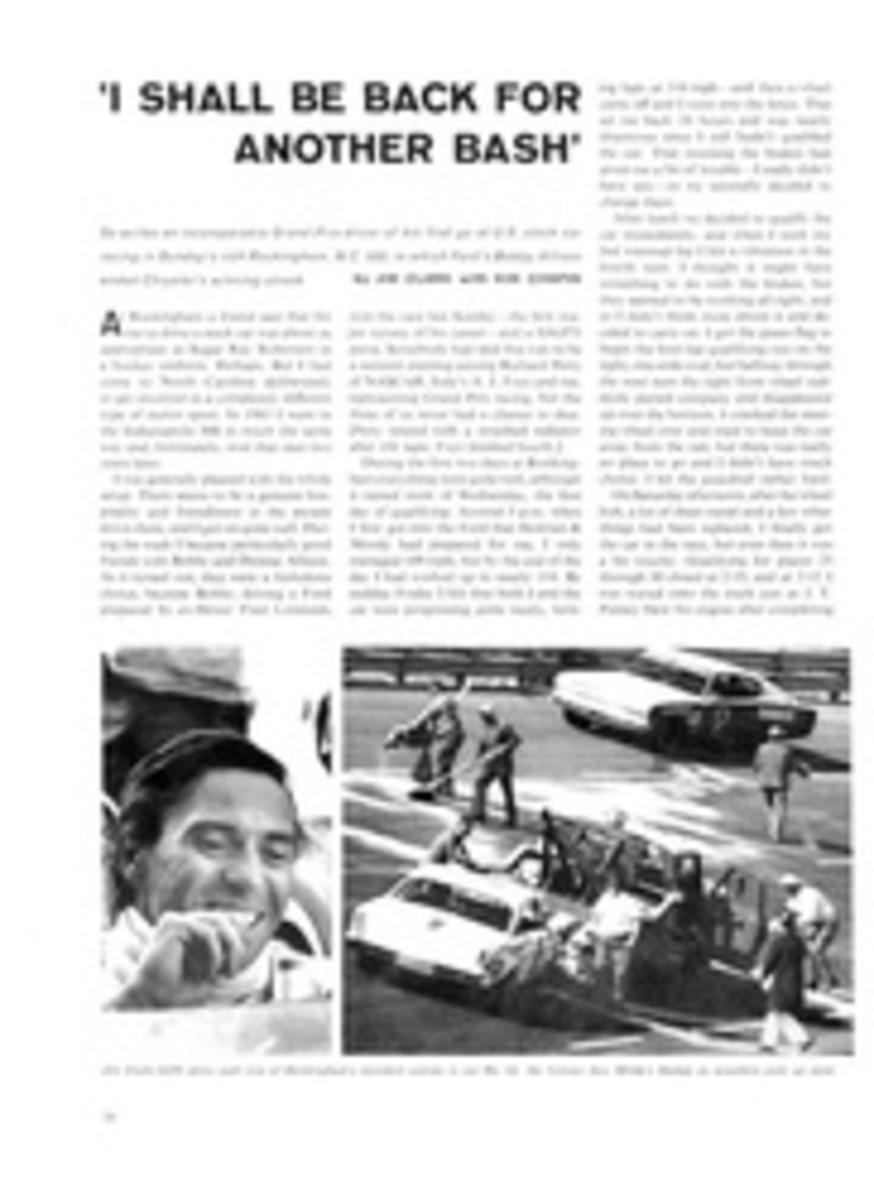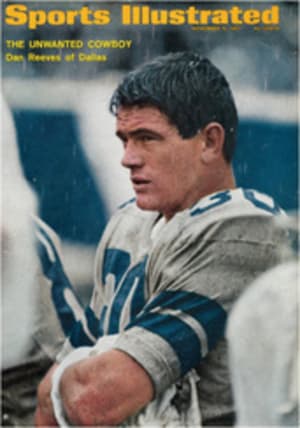
'I SHALL BE BACK FOR ANOTHER BASH'
At Rockingham a friend said that for me to drive a stock car was about as appropriate as Sugar Ray Robinson in a hockey uniform. Perhaps. But I had come to North Carolina deliberately to get involved in a completely different type of motor sport. In 1963 I went to the Indianapolis 500 in much the same way and, fortunately, won that race two years later.
I was generally pleased with the whole setup. There seems to be a genuine hospitality and friendliness in the people down there, and I got on quite well. During the week I became particularly good friends with Bobby and Donnie Allison. As it turned out, they were a fortuitous choice, because Bobby, driving a Ford prepared by ex-Driver Fred Lorenzen, won the race last Sunday—the first major victory of his career—and a $16,075 purse. Somebody had said this was to be a summit meeting among Richard Petty of NASCAR, Indy's A. J. Foyt and me, representing Grand Prix racing, but the three of us never had a chance to dice. [Petty retired with a smashed radiator after 191 laps; Foyt finished fourth.]
During the first two days at Rockingham everything went quite well, although it rained most of Wednesday, the first day of qualifying. Around 3 p.m. when I first got into the Ford that Holman & Moody had prepared for me, I only managed 109 mph, but by the end of the day I had worked up to nearly 114. By midday Friday I felt that both I and the car were progressing quite nicely, turning laps at 116 mph—and then a wheel came off and I went into the fence. That set me back 24 hours and was nearly disastrous since I still hadn't qualified the car. That morning the brakes had given me a bit of trouble—I really didn't have any—so we naturally decided to change them.
After lunch we decided to qualify the car immediately, and when I took my fast warmup lap I felt a vibration in the fourth turn. I thought it might have something to do with the brakes, but they seemed to be working all right, and so I didn't think more about it and decided to carry on. I got the green flag to begin the four-lap qualifying run on the tight, one-mile oval, but halfway through the west turn the right front wheel suddenly parted company and disappeared up over the horizon. I cranked the steering wheel over and tried to keep the car away from the rail, but there was really no place to go and I didn't have much choice. I hit the guardrail rather hard.
On Saturday afternoon, after the wheel hub, a lot of sheet metal and a few other things had been replaced, I finally got the car in the race, but even then it was a bit touchy. Qualifying for places 25 through 30 closed at 2:15, and at 2:12 I was waved onto the track just as J. T. Putney blew his engine after completing his four laps. He hit the guardrail in the No. 1 turn and left oil all over the track. Fortunately, the NASCAR officials let me make my run, and I qualified in 25th place with a speed of 114.349 mph, nearly three mph down to the fastest man.
For a driver in a new type of car on an unfamiliar course, becoming acquainted with the traffic was the big problem, not because I'm not used to driving close, but because of not knowing what the other fellow is trying to do. What should I expect if, say, I was pinned to the wall or somebody closed the gate on me in a turn? In my first year at Indianapolis, for example, I started fifth but quickly dropped back to 13th and sat just watching the other drivers.
Getting oriented on the course was a problem, too. Unlike a road course, there were no trees or houses or things like that to gauge a shutoff point on the turns. The most valuable thing Bobby Allison, who very kindly showed me the course in detail, did was to point out a black smear on the grandstand on the way into No. 1 which I could use. Drivers will employ anything they can as a shutoff signal, even a red sweater in the grandstand. This is fine, except what happens halfway through the race when the person wearing the sweater decides to move another 100 feet or so deeper into the turn? You suddenly have all sorts of troubles.
The other problem was getting used to the car itself. My Fairlane weighed around 4,000 pounds, or nearly four times as much as my Lotus-Ford Formula I racer, but the engine put out only about 100 more horsepower. That difference made the stocker feel like an overweight truck. The brakes didn't feel terribly good, and the throttle response was very strange. In a Formula car the throttle is everything, but in the stock car it was a bit of a blop. Everything happened so slow. There was very little feeling and no rapid acceleration. No big kick in the back. You just thundered along, and it didn't seem to make a tuppenny ha'penny damn whether you were on half throttle or full. But I suppose I'm spoilt in that line. However, the steering and balance were delicate by comparison.
But still, driving in heavy traffic—44 cars on a mile track—was the biggest task. Earlier in the week, when I had the track pretty much to myself, another driver said, "Clark's smart enough to stay away from anything now, but Sunday it'll be a different story. The first time he gets bumped from both sides at the same time he won't know which way to go."
Luckily, that never happened, although I understand it occurs quite frequently in stock car racing. It seems to be part of the game. I started in the middle of the field and, as in my first year at Indy, just studied the field for several laps. Then I began picking off a few of the slower cars and got up beside Don White in his Dodge Charger. Although I had never raced him, I at least knew him to be an experienced driver and knew we could have a race without anything silly happening. This lasted for a few laps and was about the only extended bit of close racing I did. I avoided two bad accidents early in the going, although I did carry somebody's bumper around for a few laps.
About 100 miles into the race I felt the engine hang. At the time I wasn't sure what it was, although it turned out to be a dropped valve which put me out of the race 40 miles later. I was able to keep on driving for a few laps, though, and did have a rather hilarious dialogue with my pit crew.
After I felt the engine hang, I came around and pointed at it. They flashed a sign: ENGINE HOT?
The next lap I shook my head and held seven fingers out the window, as best I could, to indicate I thought I was missing a cylinder.
OIL PRESSURE? they asked when I came around the next time.
No.
NO BITE? they tried.
No.
ENGINE MISSING? was the question on the following lap.
Aah, success. I nodded.
2ND IGNITION? they showed, indicating I should try the car's backup starting system. I did. It didn't cure the problem.
Finally, I pitted, on the 125th lap. The crew could find nothing immediately out of order, and I took the car out again, all along having the horrible thought that at any moment now the whole lot was going to blow asunder. It was obvious something was wrong, and 19 laps later I retired—peacefully, as it happened.
My first venture in stock car racing was over, and I came away from it quite impressed, if for no other reason than it takes a lot of stamina and ability to wheel those huge cars around 1,000 turns in five hours. When the opportunity next presents itself, I shall look forward to having another bash at it.
TWO PHOTOS
Jim Clark (left) skins past one of Rockingham's accident scenes in car No. 66. He follows Don White's Dodge as wreckers pick up Jack Bowsher's bent Ford (No. 1) and Bobby Wawak's Plymouth and trackmen mop up spilled oil.

